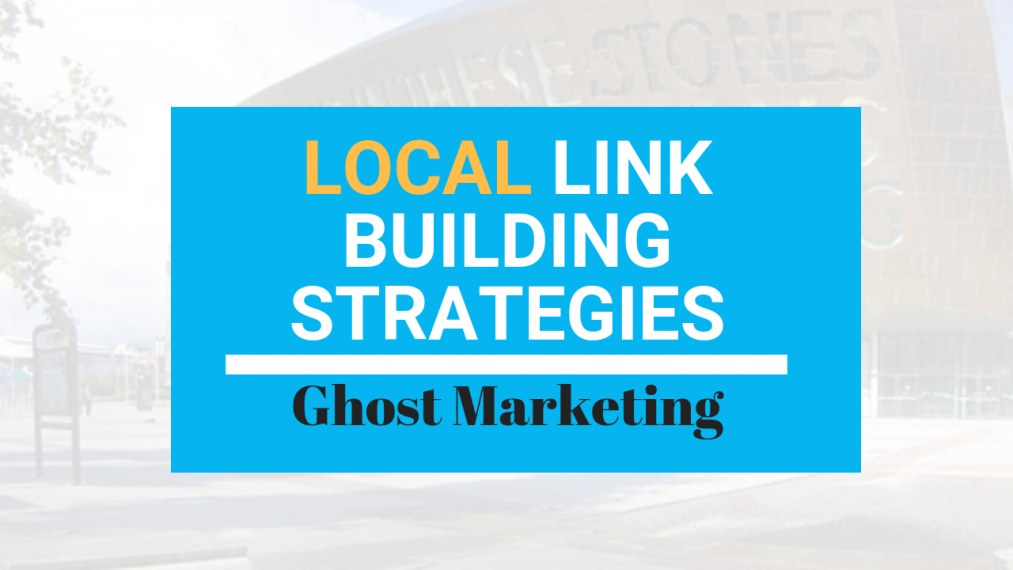Local SEO is a completely different process to ranking sites for national or international SERPs.
The reason?
Locational relevance is more important than authority. If you want to see proof, just search “restaurant + City name” or “coffee shop + city name” in Google and check the results, mine are below but of course that will change for everyone.
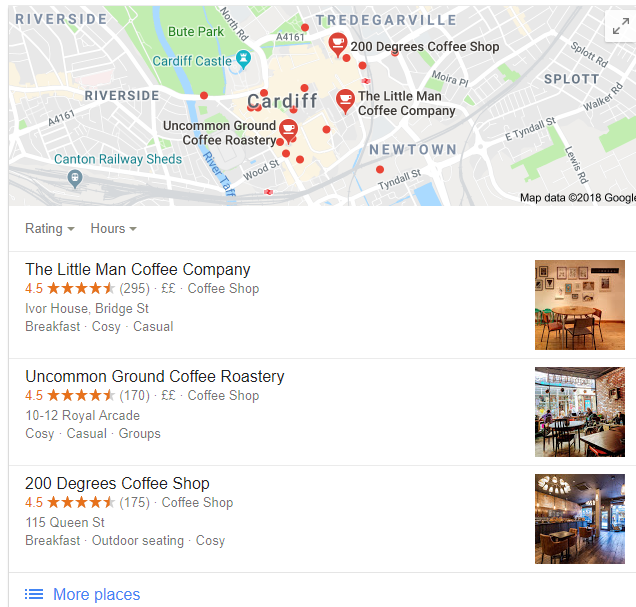
As you can see, although these 3 coffee shops are great, they are all smaller chains or independents, with only 6 locations across the UK or, this is in fact their only store.
But, what does this tell us about local SEO & Local link building in general?
Locational relevance is super important! (Potentially more so than authority….)
The reasoning behind why Google would make this the case is quite obvious if you sit down and think about it (which I do because I’m that interesting.)
Therefore, if authority were a higher weighted ranking factor for local results, all we’d see in the local search results is Mcdonalds, Starbucks, Costa etc. But we don’t. So as a result locational relevance and locational trust, plays a larger impact on overall trust and authority. Which is good, otherwise we’d live in a world of monopolies.
Searching the above example in my current location, I’m actually closer to both a Starbucks and a Mcdonalds than two of these results featured above. Which is positive as confirms this locational relevancy and trust theory.
Another element Google probably strongly knows is that massive brands have their own search volume, meaning if they were to weight branded search, UX signals and authority signals more highly, we’d only see 3 different Starbucks inside a search result…. That’s not only not all that relevant but it’s also not a great user experience for the searcher themselves.
Local Link Building – How To Merge Local SEO & Link Acquisition For Incredible Results
Link building itself comes down to 5-6 baseline strategies which others can spiral off from depending on the niche, competition, site itself etc.
For local link building these are refined to 2-3 strategies of which we’re going to outline our 2 most popular and effective we use in house to build great links on the local level in relatively quick time.
Local Content Curation & Digital PR
Of all the strategies across all types of link building (local, ecommerce, saas, national etc) – This single strategy is one that’s underused the most across the board. The reason for this is mainly due to the fact many small business owners (local business owners) do not have the knowledge or time to implement digital PR or content marketing campaigns, and hence don’t bother.
Good reasoning.
Bad outcome.
Why?
Because digital PR and content marketing campaigns drive the bottom line. The reason why these strategies are so important on the local level is that they are not implemented by your competitors, meaning you’ll have an instant edge in all your marketing. Being featured in local press will also massively increase overall exposure of the brand, as well as overall trust of said brand.
The problem with digital PR on the local level (for the majority of businesses) is simply your business is not interesting enough to generate mentions in press. Sorry but it’s true! Unless you’re in a very specific niche it’s unlikely you’ll “naturally” generate any press coverage. But you can leverage the strategies mentioned later in this post to help (donations, sponsorship etc) but for the most part, it simply isn’t possible to get mentions unless you do something press-worthy. This is why the content curation digital PR process that we’ve built is one of the most efficient ways to generate massively powerful editorial links on a predictable, repeatable basis. The strategy is outlined below.
Stage 1: Building Out The Local Content Asset
The one example I’m using in this stage is unique to our city (Cardiff, UK) but the principles can be taken out and applied worldwide. In this specific scenario, this company didn’t implement stage 2-3 at all and hence left a lot of potential exposure, links and sales on the table. I actually purchased this exact product for a present and built out a strategy for another client that worked just as well in a slightly different niche and by implementing the stage 2 and 3 as well, we saw dozens of powerful links and some great ranking movements.
The example in question can be seen here. In short it’s a simply graphic/map style display that has been creatively built out to display the top pubs/bars in Cardiff in a London Underground style map layout. The post is copyrighted but if you want to purchase the poster itself, hit the link above.
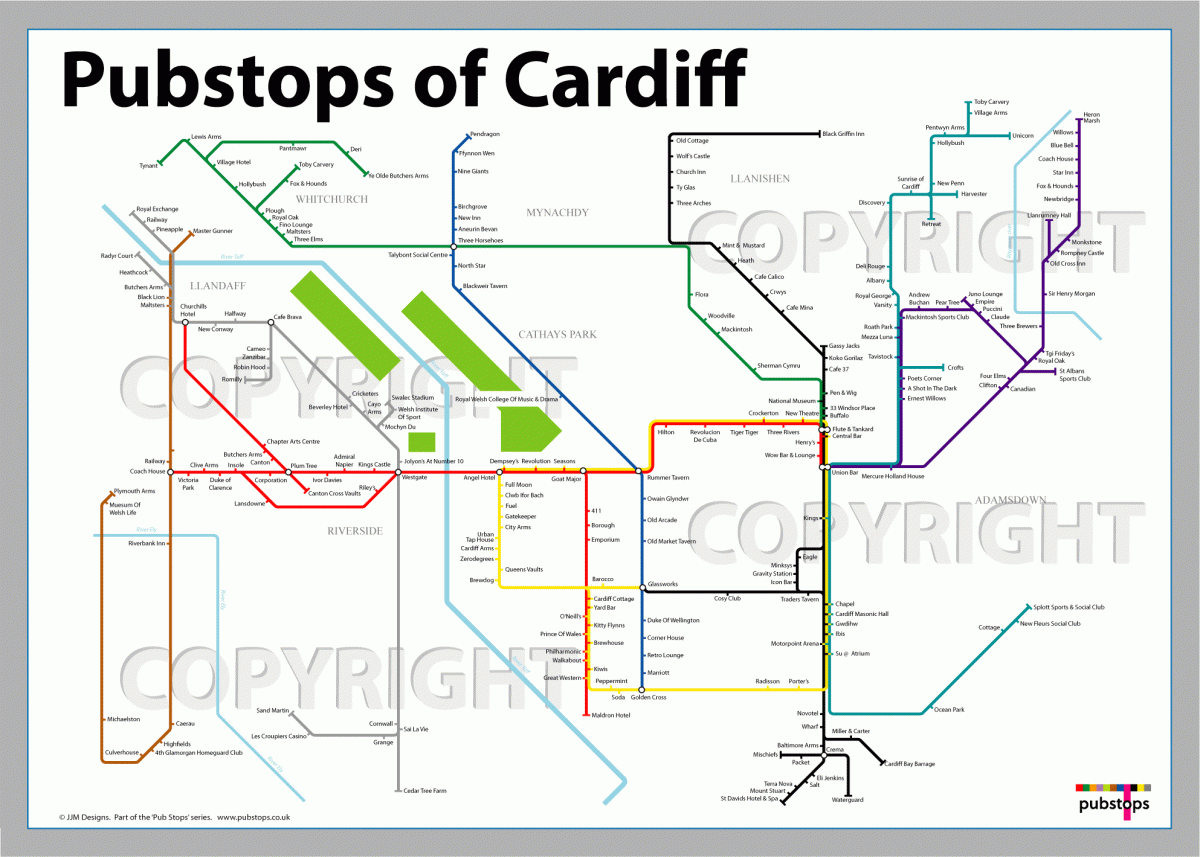
Looks cool, but what has this got to do with local link building or marketing in general?
These content assets are some of the most potentially valuable pieces of marketing material a business can own.
Above is a great example of one that (if built by a Cardiff business, or even a pub on the list) would result in a massive amount of press (and hence revenue) and also a massive amount of links (hence increased organic rankings, hence increased revenue).
Best of all, these marketing strategies are totally natural and non-obtrusive. Much better than offering discounts, buying print advertising, billboards or banner ads.
Building this content isn’t the easiest part as you have to understand PR, content marketing and content curation processes. But, saying this, a good place to start, is to determine what has worked for other companies in other cities. AKA reverse engineer what’s already working. Or look into what larger brands are doing in the same niche.
I could write another 3,000 words on the content curation process but I don’t want this to get out of hand, instead here’s a mini checklist of ideas and tips to help you build a piece that will give you the best ROI:
- Simple & Clean.
- Mainstream appeal (not too technical.)
- Short.
- Visual.
- Non-commercial.
- Related to your city.
Once you have your piece ready/being designed, it’s time to build the prospecting lists.
Stage 2: Building Out The Media & Non-Media Prospects List
Media Lists
The media list is going to be the journalists, editors and influencers who have access to local media outlets that you’d like to get featured in. These can be relatively small (depending on your city) but the goal should be to build a list of 30+ journalists/contacts that if they liked your piece (which by researching what they like we can confirm they would) would feature it in a post on an editorial or authority site.
Finding these media lists is the tough part, unless you have £500/month to spend on databases like Muckrack or Gorkana.
Assuming you don’t have access to these, simply taking advantage of Twitter’s search features is the best way to go. Looking for specific editors/journalists or contributors to specific publications. You can also do this by looking through the specific authors/contributors page of the specific publication you want to get featured on. But building up these lists are essential to the whole process working well.
Non-media lists
The great thing about local content curation campaigns is that it doesn’t have to just be about generating local press. Instead you can actually contact the businesses (in the above example this would be the pubs featured on the list) and ask them if they’d like to mention your piece of content (social or a link) – The response rates are great because the piece is so interesting, creative and unique! The best part is, if you’ve featured dozens of pubs/bars on the list, that’s dozens of relevant link opportunities!
Other link opportunities can include:
- Local bloggers.
- Other local businesses in sub-niches (In our example; restaurants etc).
Stage 3 – Outreach & Link Acquisition
Stage 3 involves the actual outreach for the link. In this stage the pitch is very important. This is something that you should constantly tweak and should vary from niche to niche.
Building rapport first and pre-outreach does work incredibly well. So for example (generally only for the media prospects) – Implement a pre-outreach around 1-2 weeks before the piece goes live, and ask them if it’s something they’d be interested in. If you get a positive response you know you have a good percentage chance of generating press with this piece in the future.
The outreach itself should be short, to the point and talk about what the person on the other end is going to get out of it.
Remember, nobody cares about you!
Instead if you talk about how this will go city-viral and generate massive amounts of coverage for that specific publication that features it and/or the journalist, they’ll bite your hand off to take it.
For the non-media outreach, you want to implement slightly different strategies, usually a more person focused approach but with the ultimate goal of generating the link placement. An example script is below.
Hey <name>,
We’ve just finished our unique content piece featuring <business name>, it’s at: URL.
It might make a great addition to your blog and get you some good exposure too, would be happy to write a little bio/introduction to go along with this if you like?
Thanks,
Tom.
Do not underestimate how insanely powerful this technique works on the local level. In many cases it works better than the national/international version because you have 1000 times less competition.
Finally for this technique remember to integrate an unlinked mentions campaign – This is where your brand/specific piece of content was featured but was not linked. Again, you can do this by leveraging advanced search operators inside of Google.
Leverage this and let me know how the results go, or get in touch if you’d like us to build this strategy out for you.
Sponsorship, Charities & Scholarships Link Building Technique
Truth be told these are actually 3 separate strategies, but as I mentioned above there’s 2 core strategies we’ll be focusing on today and this is the second.
This strategy itself leverages the “I have no time but some cash flow.” Unless you are very very early days you should be able to leverage one of the time or money currencies that you have as a business. The first is very much weighted to investing a lot of time upfront, this one will still need some time but when you get creative and use the hacks we talk about below to streamline the campaign, it makes this a lot less time-intensive.
Here’s the three strategies in detail.
Sponsorship
Sponsorship link building, as it sounds, involves going out and finding sponsorship opportunities relevant to your city. This is actually alot easier than you think and if you’re already involved in a sponsorship type relationship, or have the potential to be, then I’d recommend leveraging these first, to get a win-win-win out of it. If you don’t have any of these connections available to you, then I recommend building out the below strategy.
Part one involves finding relevant prospects, to do this we just need to use an advanced search operator inside of Google. We’re only going to be using two simple ones today and these are: inurl:sponsorship “City name” and intitle:sponsorship “city name”. I’d also actually recommend tweaking the term “sponsorship” to “sponsor” and “donate” and other variations which you can see as you go along. Below is what it should look like inside Google.
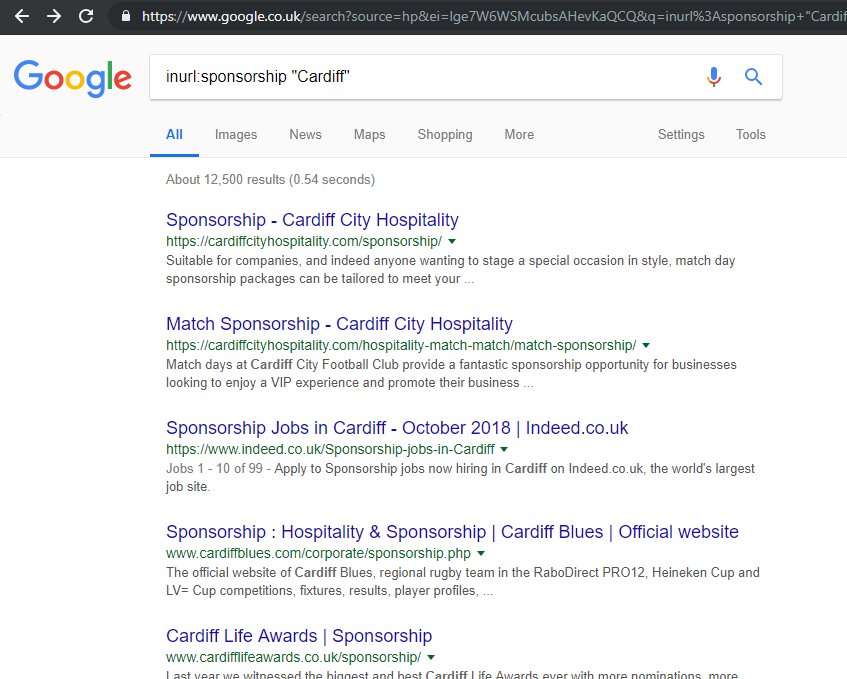
The reason why we use the advanced operators intitle: or inurl: is because if we were to just search “sponsorship” “city name”, the results are far too vast.

Once we have our SERPs open for our city, we’ll have a list of potential prospects to outreach to. The next stage is the time consuming one and one I’d recommend you outsource to a team member if possible.
This involves building an excel of all the potential sponsorship opportunities. There’s a 4-stage checklist (explained in detail in the next part of the post) we use to help us gauge the quality of the opportunities. We use Ahrefs site explorer for this amongst other things, but this checklist is explained later.
Although it’s important to prospect sites and only keep ones that have some authority and quality, you should also be aware that when it comes local link building you should have your cut-off metrics a lot lower than if it were a national or international site. The reason? Hyper local links are super-underrated. Meaning they are worth a lot more to you and hence should be kept on prospecting lists.
A Quick Note About Hyper Local Links
A hyper local link is one that’s extremely relevant to your specific city (or even a suburb in that city) but doesn’t carry a lot of authority. If you look at Domain Ratings or Domain Authority it would likely be extremely low and if you only looked at these metrics, you’d miss hundreds of great links from them being not “powerful” enough. Massive mistake on the local level, because as we know from the very start of this post = Locational relevancy & trust ranks sites.
Once we’ve developed a list of potential sites that pass the local site quality checklist (process explained in detail below) – It’s time to move onto the outreach stage.
For sponsorship sites this is actually pretty easy as most of the time you’ll actually be doing this other sites/business/club/team a favour by helping them out by purchasing something AKA sponsoring. But we want to get the most bang-for-out-buck when it comes to advertising and also avoid the obvious paid-linking elements, although this are 99% misconceptions anyway.
You should also have a budget in mind too, as some of these sites are large organisations where sponsoring will set you back £10,000+/year. You’ll of course get some great incentives and these will likely be tax write-offs but there are also great opportunities for good links around £100/year too.
To see some price lists you’ll likely have to call/email someone. This usually means the pricing is going to be on the more expensive side, just something to bear in mind. One of the top examples had this call to action to receive pricing or more information about sponsoring the event. The obvious thought process here is; if you have someone solely dedicated to gaining sponsorship, you better believe they are going to be expensive.

If you’re into a specific sport, event type or music – Feel free to sponsor these as you will likely receive a lot of perks and you can benefit both on the front and back end from your sponsorship then too.
Pro tip – Sponsor Junior Teams For Discounts
For those on tight local link building budgets, the answer is junior teams/events. As you might expect there’s a lot less support for junior teams than full professional leagues. But these sites are usually extremely hyper-local. Meaning a few links from these will increase your locationally relevancy and locationally trust massively.
For these utilise the advanced search operators as mentioned before but then add very specific types “junior football” “junior music clubs” etc. Below are two examples we found in less than 30 seconds.
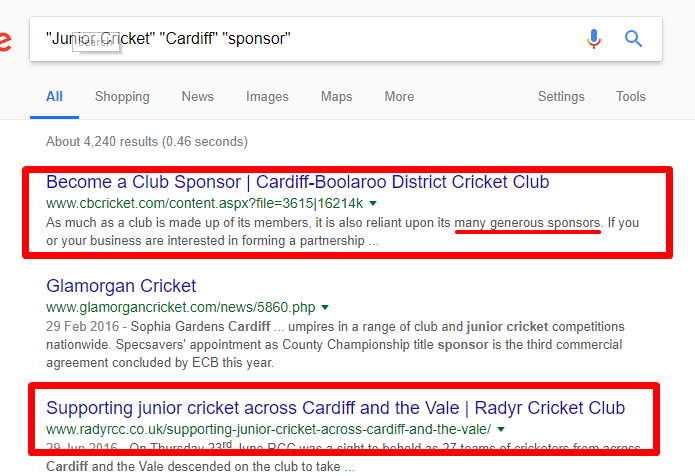
From here, simply reach out to these people, get a quote and make your decision. Next up on our local link building strategies is Charities.
Charity Link Building
As mentioned with the sponsorship elements, charities work in much the same way. On the national level, donations to be featured on the site are usually too high, but on the local level you can donate to these charities and receive a lot of positive press exposure (which could potentially generate even more links) and also you’ll receive a direct link from the charity itself in most cases for only a corporate donation.
The charity link building strategy itself is almost identical to the sponsorship strategy above, as most charities are looking for donations but you just have to ensure it’s corporate donations with the incentive of being mentioned on their site. Note: Some people might think this is unethical, I’m just mentioning the strategies that work. What I’d personally recommend is prospect a list of 10+ charities with donations in your budget range and research which is closest to your heart or you’d like to donate to the most. Then move forward with those ones.
For this I’d recommend simple operators “charity” “city name” and also looking on your local charity directories. If you have a specific affinity to a particular type of charity you can also use the search feature of these sites to narrow down your search.

Once the search is complete you’ll have a list of real charities you can help, in our example above this returned 2,500+ results (not sure if that’s correct) but either way we have a huge list of charities and link prospects we can now donate to and get a link in return for helping. In my opinion it’s the highest type of marketing synergy.

As you might imagine when reaching out to charities you need to have a little softer approach, at the end of the day if you don’t get the link, going back and saying “Hey you didn’t link to us after we donated” is a little bit of a d*ck move. Instead just increase your donation size in the future, but pre-position this with “Hey, we’ve loved to get featured on your site with a link back to our company domain, do you have a donation package for this?”
Scholarships link building
Something that SEO’s and link builders worldwide almost ruined for real businesses because they tried to do this cheaply and unethically.
If you are considering a scholarship link building campaign (which you should) then please have a real scholarship you are offering, not a fake one with the only goal to generate links….
Offering a £1,000+ a year or every 6 months is a tiny amount to pay if you can generate some powerful links from local educational institutions. And the added benefit is you genuinely help people in the process. Similar to the above charity based linking strategies this is a win-win-win for all involved.
These educational links are generally seen as being some of the most powerful links businesses can generate, so spending a little more time on this strategy wouldn’t be a bad idea.
Stage one of this strategy would involve building a page on your website where you are advertising the scholarship. This would contain all the information about the scholarship itself. You can see an example of 1st Formations page here.
If you look at the quality of sites linking to this 1st formations page, you can see how effective these strategy can be:
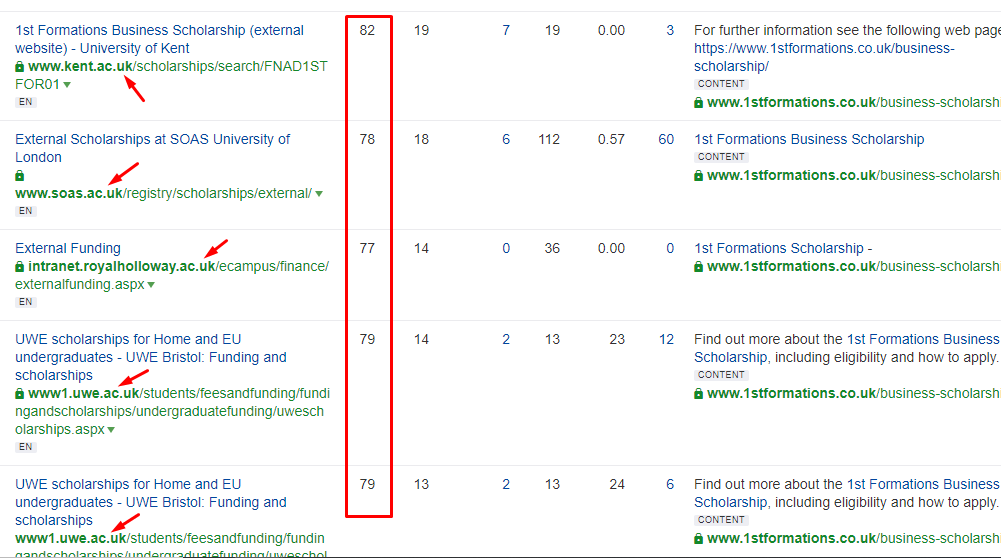
Dozens of .ac.uk links with DR’s of 75+.
These are incredibly powerful sites that you can link from, if you can get links from your educational facilities near you (locally) this effectiveness is tripled.
You can find Universities, colleges and schools that link out to external scholarship pages by either:
- Searching yourself with advanced search operators. site:.ac.uk for example. Or;
- Reverse engineering competitors (such as the above example.)
This technique is incredibly effective for generating links that are in the top 0.01% of all links you can get to your site. As a result your site’s trust (and hence rankings) will increase massively.
Remember you can tweak any niche to angle to a scholarship approach, not business or technical skills but also any business. Even if you own a small business in a very generic niche, you can create an angle around supporting students looking to advance this industry, or that the scholarship is only available for one niche/course type. Creating the angle is the easy part, but please ensure you actually follow through with the scholarship (and ask for a recording from whoever you did). This massively increases trust and hence will result in more links in the future.
Get On The Phone
This is a strategy 99% of digital marketers won’t implement, mainly because they are all introverts. But, getting someone on the phone and asking about what you are specifically looking for – Whatever local link building strategy that might be, is one of the most efficient ways to actually build links. Tonality and confidence come across over the phone, whereas this can be lost in an email, especially if there are technical elements involved.
Local Site Quality Checklist
When it comes to link building strategies of any sort, the key is to understand what you are looking for from the site. How authoritative, how relevant and essentially how valuable a link from this site would be.
To do this we need to determine the quality of these sites in a quick manner. In-house we do this through a quick checklist and common sense having probably reviewed over a million sites internally.
The checklist is below, feel free to use this yourself and add/tweak where you feel needed
- Is the site still live & active? – Was there a post within the last 2 months.
- Is the site designed well? – For local sites “well” can be reduced to “just OK” usually.
- Does the site have any authority? – Brand new sites or very low quality ones are just not useful.
- Does the site have locational relevancy? – Does it rank for local keywords?
The 30 Second Site-Check Process
Once you’ve learnt each part of the checklist you’ll be able to run through each new site in less than 30 seconds, but for this example I wanted to expand on each point:
Site Live, Active & Designed Well?
Very simply to check, simply go to the site and have a look around for 10 seconds. Is the site updated regularly? Does it look like it was built this millennium or in the 90s?
Authority?
To gauge authority simply go to Ahrefs and put the site into site explorer. You should see some sort of data here, if this is blank or a referring domains of less than 10 I’d remove the site and move straight on. Although do remember the hyper-locational point mentioned earlier in the post.


Locational Relevancy?
If the site doesn’t have much authority but you think it might still be a good prospect, the best way to confirm whether they should be kept or removed from your prospecting list is whether the site has good locationally relevancy. A good test for this is to take a look at the blog post titles of the last 10-15 posts and determine if they talk about your city/location. If they do not and are more geared to general topics, then it’s probably not worth approaching. If they do and contain external links to businesses in your specific location then they’d be a good link prospect.
In an example of a Cardiff based food and travel blogger Hungrycityhippy (screenshot below)- you can see multiple mentions of the city “Cardiff” throughout the content. This shows that the blogger/site is locationally relevant.
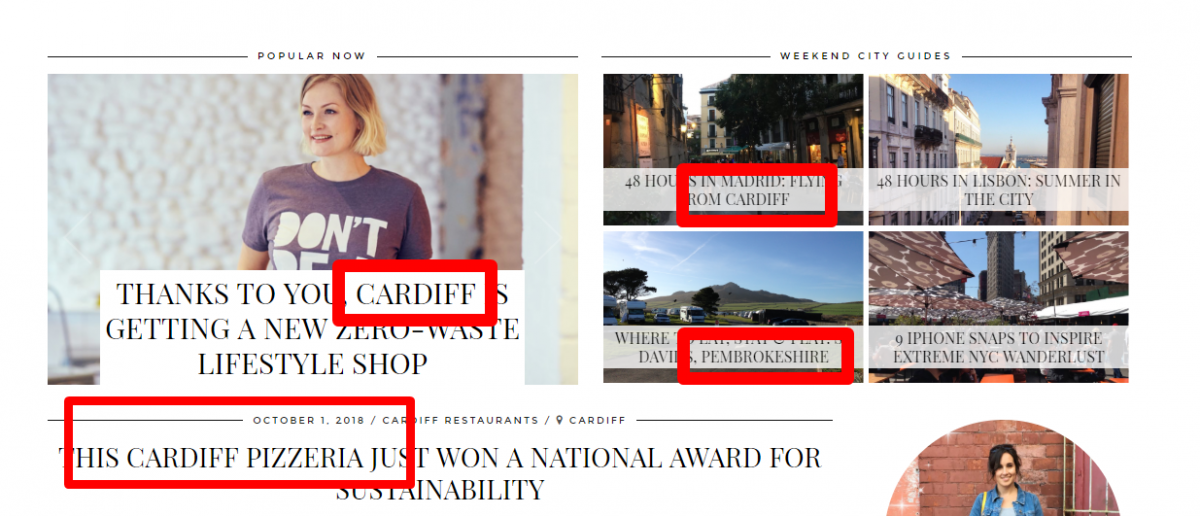
Conclusion
Local link building is an incredibly high ROI marketing activity that all locationally relevant businesses should be integrating into their strategies. Aside from the obvious benefit of getting featured in local press, local businesses and generating buzz around your products or services, local link building also in one of the largest local SEO ranking factors in 2018 and will continue to be in the future. If you have any questions about local SEO or would like to request a local link building proposal, please feel free to get in touch.
